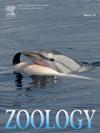翻转还是翻转?鱼对搁浅的行为反应代表六目硬骨鱼
IF 1.6
3区 生物学
Q2 ZOOLOGY
引用次数: 0
摘要
水生和两栖鱼类被困在陆地上时,会产生各种各样的行为,包括一种叫做尾巴弹跳的弹道运动。虽然最近的研究已经检查了几种棘齿动物的跳跃性能(距离),但对搁浅在陆地上的硬骨鱼产生的行为多样性知之甚少。在这里,来自四个主要硬骨鱼谱系的七个物种(单个n = - 12)被人工搁浅在陆地竞技场进行两分钟的试验。从试验录像中,对每个人的跳跃次数、脚蹬数(运动& 1个体长)、位移(总和平均)、潜伏期(运动开始的时间)和运动时间百分比进行量化。这些变量的主成分分析被用来定义四个“行为空间”:产生有效位移的物种,并且在试验期间的大部分时间都在移动(Danio);产生较少有效位移并且在试验期间大部分时间都在移动的物种(假穆吉尔);产生较少有效位移和花费很少时间移动的物种(本影);以及产生有效位移,但花费很少时间移动的物种(Kryptolebias)。根据为这项研究收集的文献和代谢数据,从空气中提取氧气的能力(相对于水)似乎预测了搁浅在陆地上所需的移动时间。呼吸空气的鱼类似乎采取了一种“观望策略”,而缺乏呼吸空气能力的物种则会立即频繁地移动,可能会试图尽快回到水中。本文章由计算机程序翻译,如有差异,请以英文原文为准。
Flip or flop? Behavioral response to stranding in fish representing six teleost orders
Aquatic and amphibious fishes produce a variety of behaviors when stranded on land, including a ballistic movement called a tail-flip jump. Although recent studies have examined jump performance (distance) in several cyprinodontiform species, less is known about the diversity of behaviors produced by teleosts when stranded on land. Here, seven species from four major teleost lineages (individual n = 4–12) were manually stranded in a terrestrial arena for two-minute trials. From videos of the trials, the number of jumps, flops (movements <1 body length), displacement (total and mean), latency (time to onset of movement), and percent time moving were quantified for each individual. A principal components analysis of these variables was used to define four “behavioral spaces:” species that produced effective displacement and spent the majority of the trial period moving (Danio); species that produced less effective displacement and spent the majority of the trial period moving (Pseudomugil); species that produced less effective displacement and spent little time moving (Umbra); and species that produced effective displacement, but spent little time moving (Kryptolebias). Based on the literature and metabolic data collected for this study, it appears that the ability to extract oxygen from air (vs. water) predicts the amount of time spent moving when stranded on land. Air-breathing fishes appear to adopt a “wait and see strategy,” while species that lack the ability to breathe air move immediately and frequently, likely an attempt to return to the water as quickly as possible.
求助全文
通过发布文献求助,成功后即可免费获取论文全文。
去求助
来源期刊

Zoology
生物-动物学
CiteScore
3.90
自引率
0.00%
发文量
37
审稿时长
70 days
期刊介绍:
Zoology is a journal devoted to experimental and comparative animal science. It presents a common forum for all scientists who take an explicitly organism oriented and integrative approach to the study of animal form, function, development and evolution.
The journal invites papers that take a comparative or experimental approach to behavior and neurobiology, functional morphology, evolution and development, ecological physiology, and cell biology. Due to the increasing realization that animals exist only within a partnership with symbionts, Zoology encourages submissions of papers focused on the analysis of holobionts or metaorganisms as associations of the macroscopic host in synergistic interdependence with numerous microbial and eukaryotic species.
The editors and the editorial board are committed to presenting science at its best. The editorial team is regularly adjusting editorial practice to the ever changing field of animal biology.
 求助内容:
求助内容: 应助结果提醒方式:
应助结果提醒方式:


